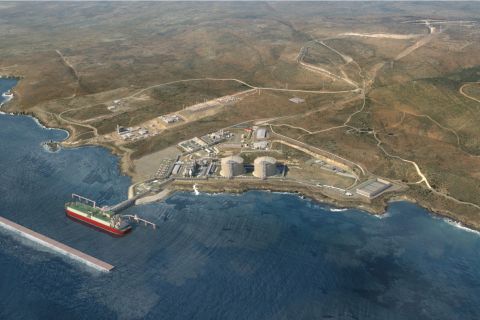Of the 77 counties in the state of Oklahoma, 70 are oil- and gas-producing. Many of the wells in those producing counties touch in some way the Mississippi Lime or Woodford Shale resources that have bumped the state back into the petroleum-producing picture that it once starred in. At Hart Energy’s recent DUG Midcontinent event, several presentations focused on the state’s resource versatility, and one keynote looked at the global energy picture.
Petrie’s perspective
If Tom Petrie peers into a crystal ball in his home in Colorado, he likely sees clouds. Not dark clouds, necessarily, just enough to mask conventional wisdom.
“One thing I’ve learned over 40 years is that the future usually turns out differently than the emerging consensus at any one time,” the chairman of Petrie Partners told an attentive crowd at the event. “And I think that’s likely to prove the case today.”
The former vice chairman of both Bank of America and Merrill Lynch is no pessimist. He has overseen more than $200 billion in energy merger and acquisition (M&A) deals in his career and possesses a keen understanding of the relationship of the industry to global geopolitics. At the moment, he sees a wealth of potential in the North American unconventional oil and gas bounty, but he tempered his rosy outlook with a list of risks and challenges that he believes the industry must recognize and confront.
“The pursuit of those shales and the power of that pursuit have become something of enormous proportions and strategic significance for the U.S.,” Petrie said. He noted three major trends that led to today’s boom in unconventional exploration and production:
- Oil price supercycle: “The industry’s pricing prospects are very event-driven, and many of those events are very geopolitical in nature. And that’s something we should not lose track of because it’s where the surprises could very well come.” Influential events in the past four decades include the Iran-Iraq war, Iranian revolution, OPEC quotas, Iraq’s invasion of Kuwait, OPEC production cutbacks, the 9/11 terror attacks, “peak oil” fears, “fiscal cliff” concerns and the Syrian civil war.
- Three M&A consolidation waves: The first was in the first half of the ’80s, another occurred in the late ’90s with the creation of oil supermajors and the third and most important in 2001 to 2005 resulted in a major consolidation of publicly traded independent companies. This last consolidation freed up a lot of intellectual capital that went back to work for private equity and played a major role in the rapid pursuit of shale opportunities.
- Evolution of technology: “The power of that notion that the old model was giving way to a new one.” M. King Hubbert built his projections of peak oil on the old model, one that involved multiple risks of generating hydrocarbons, having them migrate in a timely way, be captured in highly productive reservoirs and have a good seal. Multiplying out each of those factors creates an industry formula for wildcat success of one chance in eight.
The result: “Unlocking hydrocarbons from tight shales and doing it economically; making sure the energy in is meaningfully above the energy out; and doing it with the now-evolved state of technology where we can drill deep, go horizontal, stay in zone and achieve an unlocking of those hydrocarbons with ever-more-effective fracking designs, well seals and so on—it is, in fact, incredibly transformational,” he said.
Petrie cited research in The Future of Natural Gas, published by the MIT Energy Initiative in 2011, for his argument in favor of U.S. natural gas exports. One of the study’s co-chairs was Ernest Moniz, now the U.S. secretary of energy.
“This is a critical pressure release valve,” he said. “If one just poses the alternative of not allowing gas exports, which is clearly off the table at this point, one would realize that, in the absence of this pressure relief valve, we’d be snuffing out one of the great economic opportunities of this century, or the first half of this century.”
The MIT study reinforces a favorite theme of Petrie’s: the interaction of seemingly disparate events and how they influence the course of actions.
“If you look at this forecast that was done in 2010, there was a big component forecast by MIT for Haynesville,” he said. “We’re falling well short of that. What’s happened is the Marcellus, coming on in the way it has with its potential to actually exceed the productivity of the country of Qatar later in this decade, squeezing down productivity and the prospectivity, at least for a while, for both the Haynesville and the Fayetteville. And it’s that kind of interaction—that dependent interaction, if you will—that I think is going to characterize some of the other plays as we go forward. It’s worth keeping an eye on that.”
Petrie warned of a number of risks that demand attention by the industry. Fugitive methane is a major one. He also focused on opposition from environmental entities opposed to hydraulic fracturing.
“We really need to take the anti-fracking initiatives in Colorado and elsewhere quite seriously,” he said. “The fact is, if they gain momentum as in the past, we could begin to change the supply prospects later in this decade and certainly in the decades beyond.”
And that’s a future that Petrie does not want to see.
Evolution of the Mississippi Lime
Predictable, repeatable and oil were three of many descriptors often applied to the Mississippi Lime play in 2010 and 2011, according to Gibson Scott, director of energy research for ITG Investment Research. But now? Words such as complex, variable and NGL dominate conversations about the play.
“It is pretty clear that the industry’s understanding, and by virtue of that, investors’ perceptions of the play have changed over time,” Scott told attendees at the event. “Key themes that Mississippi Lime operators and investors face today include the variability of performance, how geologic indicators may be used to determine sweet spots in the play and how completion designs differ by operator.”
In compiling the analysis of the play for the conference, the ITG team looked at oil production data taken directly from production reports of more than 1,000 Oklahoma and Kansas wells. Public operators included in the analysis were Chesapeake Energy, Devon Energy, Midstates Petroleum, Range Resources and Sandridge Energy.
“Few plays are as geologically complicated—or found in jurisdictions with data qualities as challenging—as the Mississippi Lime play in Oklahoma and Kansas,” he said. “We spent a great deal of time collecting, parsing, scrubbing and analyzing oil production data directly from production reports rather than the state data.”
These well production reports provided many key insights. Take, for example, variability in well performance across the play. It is driven by both geology and operator completion designs, Scott said.
Noting that the data showed a general trend to oilier production moving east across the Nemaha outlet, he added that the hydrocarbon mix is extremely variable, even across short distances. “The geology of the Mississippi Lime itself is extremely complex,” he said. “Often a single lateral may encounter limestone, dolomite and chat.”
It is due to this variability that most operators tend to focus on discrete regions of the play, he said, with small programs varying widely from the mean. Plotted out, the well data showed that Midstates Petroleum achieved the highest per-well oil productivity of the group, about 200 bbl/d on average.
“Sandridge and Midstates have drilled some of the best-performing individual wells within our sample,” Scott said. “In fact, several wells drilled in Grant, Woods and Alfalfa counties produced more than 1,500 barrels per day during their peak month.”
High-rate wells, or those wells that produced more than 1,000 bbl/d during their peak month, showed a steep decline profile, Scott noted, with production from an average high-rate well falling 90%.
“Overall, we observe a peak calendar month IP-to-EUR [initial production to estimated ultimate recovery] relationship of about 1 to 600, which indicates that the Mississippi Lime average well, or at least its oil production, tends to decline more steeply than some of the other resource plays we look at,” he said.
The completions process also can have an impact on the performance of Mississippi Lime wells. “Given the geologic variability of the plays, it’s pretty unlikely that one practice would fit all regions,” he said. “We believe that operators will have to tailor their specific approach to their own respective areas.”
The typical Mississippi Lime well today is drilled with about a 1,219-m (4,000-ft) lateral, up from 762 m (2,500 ft) in 2009, he said. About a million pounds of sand was typically used in these wells, a figure that has remained pretty consistent over the past three to four years.
“Chesapeake historically used the most proppant in its completions,” he said. “In fact, Chesapeake has decreased its sand volumes each year and is now more in line with Sandridge’s at about 700,000 pounds of sand. This doesn’t appear to have materially impacted its test rate, which actually climbed over time.”
The analysis found that the average Mississippi Lime well recovers about 97 Mbbl of oil, with Alfalfa and Woods counties exhibiting best-in-class peak oil rates and recoveries, Scott said, adding that activity here is dominated by Chesapeake, Midstates and Sandridge.
“In terms of Chesapeake specifically, its activity is really concentrated in Alfalfa and Woods counties, where it’s achieved a three-year average oil recovery of more than 120,000 barrels,” he said. “We estimate that Chesapeake’s most recent wells recover more than 130,000 barrels of oil.”
Woods and Alfalfa counties are home to most of Midstates’ activity, he noted, adding that while its oil recoveries have deteriorated, they still remain among the best in class for Mississippi Lime operators.
Devon’s activity spans five counties focused east of the Nemaha outlet, according to Scott. “Although production east of the Nemaha is generally oilier, oil recoveries tend to be lower,” he said. “We estimate Devon’s most recent wells recover about 60,000 barrels of oil, with its best results coming from Payne and Noble counties.”
Range Resources’ activity also is concentrated east of the Nemaha outlet and is similar to Devon in its production results. Its wells tend to be oilier and also tend to recover less oil, according to Scott. “We estimate that Range’s Mississippi Lime wells recover about 70,000 barrels of oil on average,” he said.
With activity in 16 of 22 counties, Sandridge is the more widely distributed operator across the play. “Alfalfa, Harper and Grant are among its best performing counties,” he said. “Sandridge also has exposure in Sumner County, Kansas, which may identify as being an emerging and a potential new core area. Our average Sandridge curve, which includes its exploratory and extensional acreage, recovers 99,000 barrels of oil over a 30-year well life.”
While performance across the play varies widely, Scott noted that operators like Sandridge are able to gain a competitive advantage through large statistical programs, established infrastructure and cost-saving measures. Companies like Midstates were dealt a better hand geologically, but each company will have to tailor its own drilling and completion designs for its respective areas, he said, adding that “we’re still on the learning curve in terms of what’s going to work best in each area.”
Vitruvian SCOOPs up success
By the end of this year, Vitruvian Exploration II aims to have 16 producing horizontal wells in the Woodford South Central Oklahoma Oil Province (SCOOP) shale play with an operated production growth of 270%.
Richard Lane, the company’s president and CEO, shared insight on the company’s operations and plans for the SCOOP area during the event. The company is entering the second year of its drilling campaign in the area after acquiring Chitwood-Knox legacy assets in December 2012.
“What really got us interested in the SCOOP area was the excellent reservoir rock,” Lane said. “Our team described it as the best unconventional reservoir rock that we’ve come across. That’s after looking at a lot of plays in a lot of different basins.
“It’s got the right kerogen type. It’s got great organic carbon. It has good maturity indexes. It has the condensate to go with it and the NGL,” Lane continued, later adding the average EURs are greater than 2 MMboe. “The thickness is excellent, [with] high porosities, good permeability, fairly silica-rich rock. All of that gives rise to a tremendous resource with about 150 Bcf to 200 Bcf [4.2 Bcm to 5.7 Bcm] per section.”
Vitruvian operates about 62 sections. The Woodlands, Texas-based company’s SCOOP assets, totaling about 38,000 contiguous net acres, are located in a highly concentrated liquids-rich window. About 350 vertical wells came with the purchased acreage. “We have to manage those vertical wells, but the other nice attribute is that our acreage block is held by production,” Lane said.
But this year Vitruvian will dive deeper into its drilling campaign, investing $181 million. The company currently has three rigs operating, with averaged IPs of about 1,400 boe/d. A fourth rig is expected to be operating by July 2014. Plans for the year includes spudding six 1,372-m (4,500-ft) laterals and 12 laterals of 2,286 m (7,500 ft). Of the 18 wells spudded, hopes are for 16 to be producers by year-end, with production ramping up to about 12,000 boe/d.
That equates to revenue. The company anticipates bringing in more than $12 million in revenue per month and will consider adding rigs based on how well operations go in the first half of this year. “In the pretty near term, with the activity levels we have planned, this starts to be a self-funding asset from the cash-flow that is generated,” Lane said.
However, the positive outlook doesn’t mean there is nothing left to learn or improve.
Vitruvian has learned that not all wells are the same. Each requires area-specific optimization. The company is learning, as it goes, where to drill wells longer and where not to and continues to learn from its nonoperated interests to gain data points to obtain more knowledge.
Recommended Reading
US Expected to Supply 30% of LNG Demand by 2030
2024-02-23 - Shell expects the U.S. to meet around 30% of total global LNG demand by 2030, although reliance on four key basins could create midstream constraints, the energy giant revealed in its “Shell LNG Outlook 2024.”
Permian Gas Finds Another Way to Asia
2024-04-30 - A crop of Mexican LNG facilities in development will connect U.S. producers to high-demand markets while avoiding the Panama Canal.
CERAWeek: LNG to Play Critical Role in Shell's Future, CEO Says
2024-03-19 - Sawan said LNG will continue to play a critical role adding that LNG currently makes up around 13% of gas sales but was expected to grow to around 20% in the coming 15 to 20 years.
Silver Linings in Biden’s LNG Policy
2024-03-12 - In the near term, the pause on new non-FTA approvals could lift some pressure of an already strained supply chain, lower both equipment and labor expenses and ease some cost inflation.
Antero Poised to Benefit from Second Wave of LNG
2024-02-20 - Despite the U.S. Department of Energy’s recent pause on LNG export permits, Antero foresees LNG market growth for the rest of the decade—and plans to deliver.





